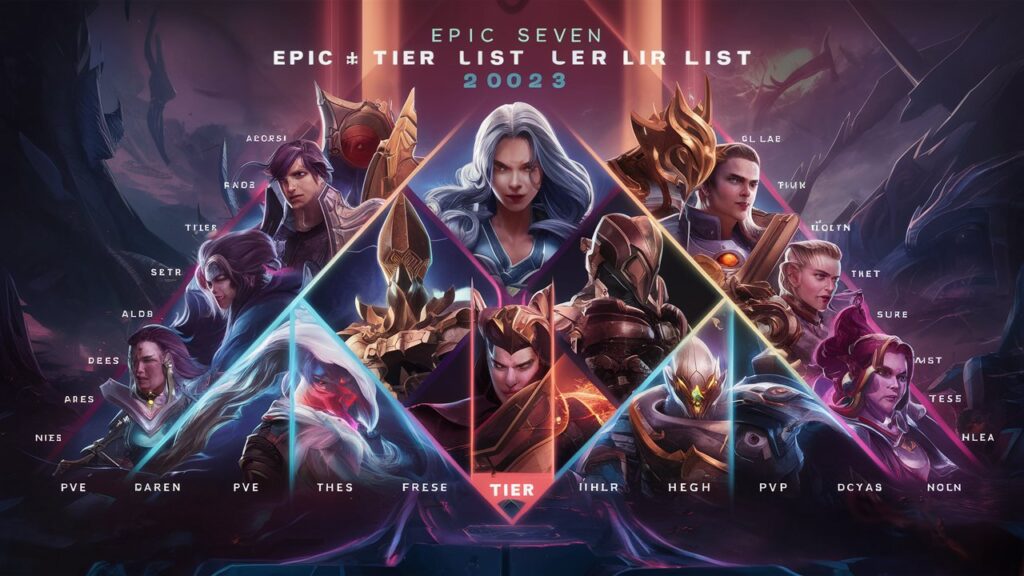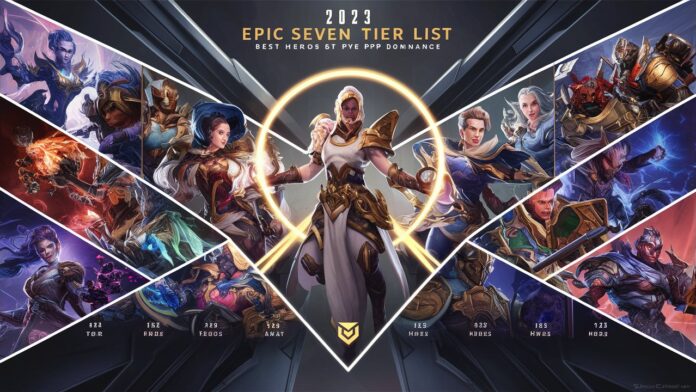Introduction to the Epic Seven Tier List
Epic Seven, the visually stunning turn-based RPG, has captivated players with its deep roster of heroes, strategic combat, and ever-evolving meta. A tier list serves as a critical tool for both newcomers and veterans to prioritize resource investment, team-building, and content progression. However, tier lists are inherently subjective, shaped by factors like hero rebalances, new character releases, and shifts in PvE (Player vs Environment) or PvP (Player vs Player) metas. This article breaks down the Epic Seven tier list for 2023, providing insights into hero rankings, their roles, and how they fit into the current competitive landscape. Whether you’re tackling Abyss hunts or climbing the Arena ladder, this guide will help you optimize your roster.
Understanding the Epic Seven Tier List Framework
Tier lists categorize heroes based on their versatility, synergy, and performance across game modes. Heroes are ranked from S-tier (meta-defining powerhouses) to C-tier (niche or outclassed units). Key criteria include:
- Damage Output: Burst potential and sustained DPS.
- Utility: Buffs, debuffs, and crowd control (e.g., stuns, silences).
- Survivability: Tankiness, healing, or evasion mechanics.
- Meta Relevance: Effectiveness against popular Arena defenses or Raid bosses.
Heroes like Arbiter Vildred and Specter Tenebria often dominate S-tier due to their unparalleled damage and survivability, while support units like Tamarinne shine in PvE for their cleansing and healing.
S-Tier Heroes: The Meta-Defining Powerhouses
S-tier heroes are indispensable in most team compositions. In PvP, units like Lua (with her speed manipulation and AoE debuffs) and Zio (a dark warrior who punishes buff-heavy teams) excel. For PvE, Sigret remains a staple for Wyvern Hunt 13 due to her Defense Break and Bleed synergy.

Key S-Tier Picks:
- Arbiter Vildred: A resurrecting AoE nuker who thrives in both PvP cleave teams and PvE farming.
- Belian: Shuts down soul-based strategies in PvP, making her a cornerstone of Arena defense.
- Specter Tenebria: High evasion, stealth, and burst damage cement her as a top-tier threat.
These heroes often require optimal gear (e.g., Speed/Immunity sets) but reward players with consistent dominance.
A-Tier Heroes: Strong Contenders with Situational Limits
A-tier heroes are powerful but lack the universal applicability of S-tier units. They excel in specific scenarios or require team synergy to shine. Examples include:
- Clilias: A knight with provoke and CR manipulation, ideal for disrupting PvP teams.
- Lionheart Cermia: A counterattack-focused fire warrior who dominates Guild Wars.
- Roana: A hard counter to dual-attack and counter teams in PvP.
While A-tier heroes may not single-handedly carry battles, they fill critical roles when paired with meta units.
B-Tier Heroes: Niche Picks with Strategic Value
B-tier heroes are situational but valuable in certain content. For instance:
- Charles: A knight-warrior hybrid with counterattacks, useful in early-game PvE and specific PvP setups.
- Luluca: Provides AoE Defense Break and barriers, aiding mid-game Wyvern teams.
- Krau: A tank with a devastating HP-scaling nuke, still relevant in Arena offense.
These units often require specialized gear or team compositions but can outperform higher-tier heroes in the right context.
C-Tier Heroes: Outclassed but Not Useless
C-tier heroes struggle in the current meta due to power creep or limited kits. Examples include:
- Serila: A fire mage overshadowed by newer AoE damage dealers.
- Corvus: A bruiser whose long ramp-up time makes him impractical in fast-paced PvP.
However, some C-tier heroes like Gloomyrain (a cleanser for debuff-heavy stages) still find use in niche PvE content.
Factors Influencing Tier List Rankings
- PvE vs PvP Performance: Heroes like Tamarinne (S-tier in PvE) may drop to A-tier in PvP due to speed meta constraints.
- Gear Dependency: Units like Vildred need high Critical Damage and Speed to function optimally.
- Meta Shifts: The rise of injury-focused heroes (e.g., Zahhak) can diminish the value of healers like Angelica.
How to Use This Tier List Effectively
- Build Around S-Tier Heroes: Prioritize gearing and awakening meta-defining units.
- Fill Gaps with A/B-Tier: Use A/B-tier heroes to counter specific threats (e.g., Roana vs Remnant Violet).
- Experiment: Tier lists are guidelines—unconventional picks like Furious (Wyvern specialist) can still dominate.
Conclusion: Adapting to Epic Seven’s Ever-Changing Meta
The Epic Seven tier list is a dynamic tool, not a rigid mandate. While S-tier heroes offer the safest investment, creativity and understanding of synergies often trump raw power. Stay updated with balance patches, experiment with team comps, and don’t underestimate niche picks. Whether you’re conquering Automaton Tower or battling in RTA (Real-Time Arena), flexibility and strategic foresight will always be your greatest assets.
Frequently Asked Questions (FAQs)
Q1: How often does the Epic Seven tier list change?
A: The tier list evolves with major updates, balance patches, and new hero releases—check monthly for adjustments.
Q2: Are C-tier heroes worth building?
A: Some C-tier heroes excel in niche scenarios (e.g., Mistychain in Banshee Hunt). Build them only if they solve a specific problem.
Q3: Which hero is best for beginners?
A: Sigret (Wyvern DPS) and Angelica (healer) are PvE staples that ease progression.
Q4: Does PvP tier list differ from PvE?
A: Yes! Units like Seaside Bellona (PvE) and Peira (PvP) specialize in different modes.
Q5: Where can I find updated tier lists?
A: Follow community hubs like the Epic Seven subreddit, YouTube creators (e.g., YDCB), and sites like Epic7x.com.
Craft your strategies, refine your gear, and dominate the world of Orbis with confidence! 🎮🔥


